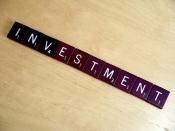GDP = Consumption + Investment + Government + (Exports - Imports). Consumption spending by individuals, by far the largest portion of GDP (ñ 70%), includes goods and services used up in a relatively short period of time. These are goods and services which people buy on a regular basis, such as food, entertainment, rent, clothes, and gas. Investment spending accounts for the second largest portion of GDP (ñ 15%). These are goods and services that will provide future benefits and allow for greater production in the long-run. Examples are spending on factories, equipment, research and development, and new houses. Net Exports is calculated by subtracting imports, or those goods we buy from abroad (ñ 14%), from exports, or those goods other countries buy from us (ñ 10%).
Consumption spending is influenced foremost by disposable income (income after taxes). As disposable income rises, consumption rises; as disposable income falls, consumption falls.
Thus, higher tax rates would reduce disposable income and cause consumption spending to fall. A second part of consumption, autonomous spending, doesn't depend on current income. People without incomes will borrow or withdraw from past savings (wealth) to pay for necessities. Autonomous consumption depends on expectations of future income, future economic conditions, wealth, and interest rates. If people expect a future raise, predict a healthy economy, or have more wealth, they will likely consume more. If interest rates increase, borrowing becomes more expensive and the opportunity cost of not leaving money in the bank rises. Thus, higher interest rates will cause most people to save more and consume less.
Businesses invest because they think it will increase profits and lower costs. Thus, investment spending is determined by expectations of future revenues, costs, and economic conditions. If people begin spending more, businesses will have incentives to increase production capabilities. To do...


